Onychoteuthidae
Hooksquids
Michael Vecchione, Richard E. Young, Kotaro Tsuchiya, and K.S. BolstadThe following six genera with about 16 species are presently recognized in the family but the systematics within the family is unstable.
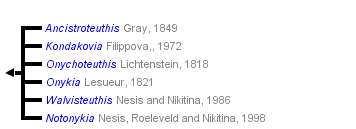


This tree diagram shows the relationships between several groups of organisms.
The root of the current tree connects the organisms featured in this tree to their containing group and the rest of the Tree of Life. The basal branching point in the tree represents the ancestor of the other groups in the tree. This ancestor diversified over time into several descendent subgroups, which are represented as internal nodes and terminal taxa to the right.

You can click on the root to travel down the Tree of Life all the way to the root of all Life, and you can click on the names of descendent subgroups to travel up the Tree of Life all the way to individual species.
For more information on ToL tree formatting, please see Interpreting the Tree or Classification. To learn more about phylogenetic trees, please visit our Phylogenetic Biology pages.
close boxIntroduction
Onychoteuthids are small (ca. 7 cm ML) to large (ca. 150 cm ML), muscular squids that have two series of smooth-ringed suckers on the arms and two series of hooks on the tentacular clubs (rarely marginal suckers as well). Some species are common open ocean squids (e.g., Onychoteuthis spp.); others live near the ocean floor along continental or island slopes (bathyal region) (e.g., Onykia spp.).
Diagnosis
An oegopsid ...- with buccal connectives attaching to ventral borders of arms IV.
- with hooks on tentacular clubs.
- with rostrum on conus of gladius.
Characteristics
- Arms
- Arm suckers biserial with smooth rings except in mature males of Walvisteuthis.
- Hectocotylization absent in Onykia and Onychoteuthis; unusual sexual dimorphism exists in Walvisteuthis; mature males of other genera not known.
- Tentacles
- Tentacular club with two medial series of hooks; ventromedial series with larger hooks.
- Marginal club suckers absent in subadults of most genera.
- Club suckers generally limited to carpal locking-apparatus and terminal pad in subadults.
- Carpal locking apparatus with circular to oval shape that is usually defined by a ridge or elevation.
- Buccal crown
- Buccal connectives attach to ventral sides of Arms IV.
- Head
- Head with numerous occipital folds in some genera.
- Beaks
- Lower beak with a step following jaw angle.
 Click on an image to view larger version & data in a new window
Click on an image to view larger version & data in a new window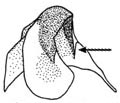
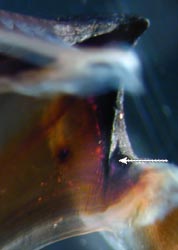
Figure. Anterior-oblique views of the lower beak. Arrows point to the step of both beaks. Left - Notonykia africanae, 100 mm ML, paratype. Modified from Nesis, et al., 1998. Right - Walvisteuthis virilis, mature male, NMNH specimen. The step ("angle ridge") lies just beyond the jaw angle where the rostral edge continues medially onto the lateral wall. That is, where the rostral edge merges into the lateral wall, the two are not flush along the medial beak surface. A well defined step is a characteristic feature of the lower beak of all members of the Onychoteuthidae. Such a step is seen outside the family only in Pholidoteuthis boschmai and to a lesser extent in some Enoploteuthis (Clarke, personal communication). Photograph by R. Young.
- Lower beak with a step following jaw angle.
- Funnel
- Funnel locking-apparatus with straight groove.
- Photophores
- Photophores present only in Onychoteuthis and Ancistroteuthis.
- Gladius
- Gladius with primary conus.
- Gladius with rostrum, usually prominent.
Comments
The following table compares the major features that separate the genera.| Genus | Many occipital folds | Visceral photophores | Gladius rostrum | Warts or wrinkles in skin | Club: marginal suckers | Fin shape |
|---|---|---|---|---|---|---|
| Ancistroteuthis | Yes | No | Thin, pointed | No | No | Sagittate |
| Kondakovia | No | No | Thick, pointed | No | Yes | Rhomboidal |
| Notonykia | Yes | No | Thin, pointed | No | No | Rhomboidal |
| Onychoteuthis | Yes | Yes | Thin, pointed1 | No | No/few | Rhomboidal/sagittate |
| Onykia | No | No | Thick, pointed | Yes2 | No | Rhomboidal/sagittate |
| Walvisteuthis | No | No | Thin, rounded | No | Few | Oval |
2 - Except in O. knipovitchi.
The following drawings illustrate the characters used in the table above.

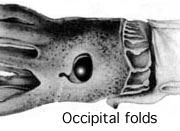

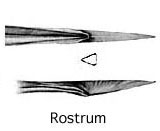
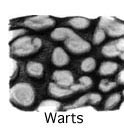

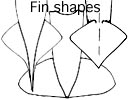
Top row:
- Occipital folds - Side view of the head of Onychoteuthis sp. Drawing modified from Pfeffer, 1912.
- Visceral photophores - Ventral view, Onychoteuthis sp., off Florida. Drawing from Young, 1972.
- Rostrum of gladius - Ventral and side views, Onykia ingens. Drawing modified from Pfeffer, 1912.
Bottom row:
- Warts - Skin of Onykia ingens. Drawing modified from Pfeffer, 1912.
- Marginal suckers - Oral view of tentacle club of Kondakovia longimana. drawing from Filippova, 1972
- Fin shapes: Left - Onykia robsoni, sagittate fins. Drawing modified from Kubodera et al. (1998). Middle - Walvisteuthis rancureli, Oval fins. Drawing modified from Kubodera et al., 1998. Right - Kondakovia longimana, rhomboidal fins. Drawing modified from Filappova, 1972.
Nomenclature
A list of all nominal genera and species in the Onychoteuthdae can be found here. The list includes the current status and type species of all genera, and the the current status, type repository and type locality of all species and all pertinent references.
Discussion of Phylogenetic Relationships
Bonnaud et al. (1998) conducted the only phylogenetic study of the family to date that included cladistic methodology. Their study, based on morphometrics and on molecular analyses of the 16S mitchondrial gene, must be considered preliminary because of the sparse material obtained for the study. Their morphometric analysis did not include many non-meristic characters, such as presence or absence of photophores, traditionally used in onychoteuthid systematics. Their molecular results support monophyly of the family but indicate that the genus Onykia (their Moroteuthis) may not be monophyletic (the outlier was O. knipovitchi) which was more distantly related to a monophyletic group of O. robusta, O. robsoni and O. ingens than was Walvisteuthis rancureli (their Onykia sp.). However, their bootstrap values were low. As can be seen in the following pages, several morphological features (e.g., smooth skin, long, asymmetrical ventral club hooks) indicate that O. knipovitchi is an atypical member of the genus.

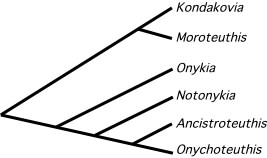
Figure. Phylogenetic tree of the Onychoteuthidae from Nesis (2000).
Nesis (2000) using a more traditional approach based on morphology and ecology suggested relationships among genera (figure above). Walvisteuthis was not recognized as a member of the family at the time and Nesis did not accept the synonomy of Onykia and Moroteuthis. Nesis used the presence or absence of ammonium chloride (a bouyancy device) to separate the two major lineages (present in Kondakovia and "Moroteuthis").
Distribution
The family is absent from the Arctic Ocean but, otherwise, is found throughout the world's oceans (Nesis 1982/87).
References
Arkhipkin, A. I. and Ch. M. Nigmatullin. 1997. Ecology of the oceanic squid Onychoteuthis banksi and the relationship between the genera Onychoteuthis and Chaunoteuthis (Cephalopoda: Onychoteuthidae. J. Mar. Biol. Ass. U. K. 77:839-869.
Bonnaud, L., P. G. Rodhouse and R. Boucher-Rodoni. 1998. A phylogenetic study of the squid family Onychoteuthidae (Cephalopoda: Oegopsida). Proc. R. Soc. Lond. B 265:1761-1770.
Kubodera, T., U. Piakowski, T. Okutani and M. R. Clarke. 1998. Taxonomy and zoogeography of the family Onychoteuthidae. Smithson. Contr. to Zool., No. 586 (vol. II):277-291.
Nesis, K. N. 1982/87. Abridged key to the cephalopod mollusks of the world's ocean. 385,ii pp. Light and Food Industry Publishing House, Moscow. (In Russian.). Translated into English by B. S. Levitov, ed. by L. A. Burgess (1987), Cephalopods of the world. T. F. H. Publications, Neptune City, NJ, 351pp.
Nesis, K.N. 2000. Squids of the family Onychoteuthidae: phylogeny, biogeography, and way of life. Zoologichesky Zhurnal, 79(3):272-281.
Nesis, K. N. and I. V. Nikitina. 1986. A new family of deepsea squids (Cephalopoda, Oegopsida) from the Southeastern Atlantic. Zool. Zhurn. 65: 47-54.
Nesis, K. N. and I. V. Nikitina 1992. New records of oceanic squids Walvisteuthis virilis Nesis et Nikitina, 1986 and Nototeuthis dimegacotyle Nesis et Nikitina, 1986 (Cephalopoda, Oegopsida) from the South Atlantic and the South Pacific. Ruthenica 2: 55-58.
Nesis, K. N., M. A. C. Roeleveld and I. V. Nikitina. 1998. A new genus and species of onychoteuthid squid from the Southern Ocean. Ruthenica 8:153-168.
Tsuchiya, K. and T. Okutani. 1991. Growth stages of Moroteuthis robusta (Verrill, 1881). Bull. Mar. Sci. 49:137-147.
Young, R. E. 1972. The systematics and areal distribution of pelagic cephalopods from the seas off Southern California. Smithson. Contr. Zool., 97: 1-159.
Title Illustrations

| Scientific Name | Onychoteuthis |
|---|---|
| Location | off Hawaii |
| View | side view |
| Copyright |
© 1996 Richard E. Young

|
About This Page

National Museum of Natural History, Washington, D. C. , USA
Richard E. Young

University of Hawaii, Honolulu, HI, USA

Tokyo University of Fisheries, Tokyo, Japan

EOS Research Institute, Auckland University of Technology
Correspondence regarding this page should be directed to K.S. Bolstad at
Page copyright © 2003 , Richard E. Young, , , and M. Vecchione, and
- Content changed 09 July 2007
Citing this page:
Vecchione, Michael, Young, Richard E., Tsuchiya, Kotaro, and Bolstad, K.S. 2007. Onychoteuthidae . Hooksquids. Version 09 July 2007. http://tolweb.org/Onychoteuthidae/19419/2007.07.09 in The Tree of Life Web Project, http://tolweb.org/





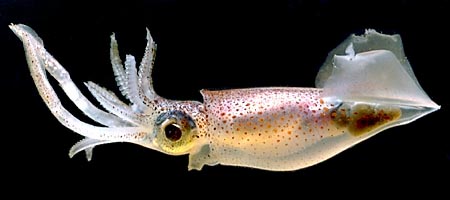

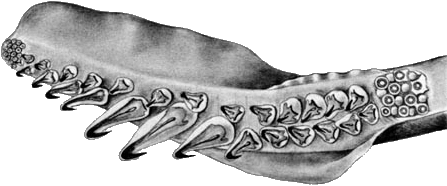



 Go to quick links
Go to quick search
Go to navigation for this section of the ToL site
Go to detailed links for the ToL site
Go to quick links
Go to quick search
Go to navigation for this section of the ToL site
Go to detailed links for the ToL site